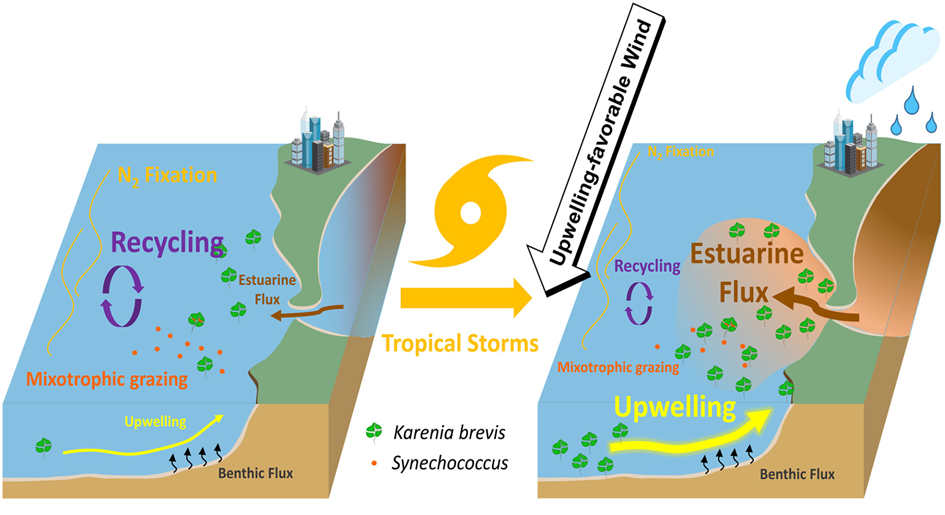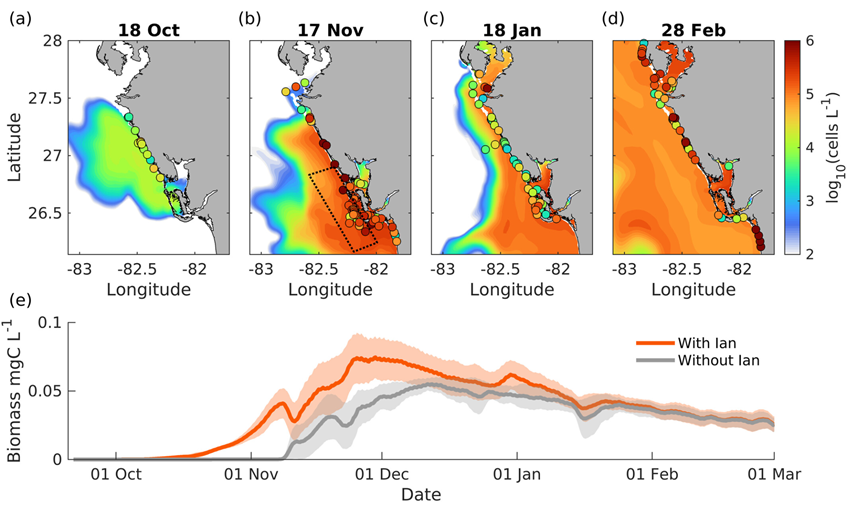A study funded by NOAA’s National Centers for Coastal Ocean Science found that hurricanes and other extreme weather events might be important drivers behind some toxic red tide blooms on Florida’s west coast.
Red tides are caused by blooms of Karenia brevis, an algae that can produce potent toxins that can kill sea animals and cause serious illness in people who eat contaminated shellfish. Breaking waves also release the toxins into the air, causing a temporary, minor cough to much more serious health complications for those with underlying respiratory issues. Understanding the potential causes of red tides will help coastal communities prepare for blooms and minimize harm.
The research team found that strong winds and heavy rainfall from Hurricane Ian, which made landfall near Cayo Costa, Florida, on September 28, 2022 as a Category 4 storm, may have created optimal conditions that sustained a toxic Karenia brevis bloom for six months after the storm.
The researchers created a model that simulated Hurricane Ian’s wind, current, and coastal runoff patterns, as well as how bottom sediments were suspended and transported as a result of the storm. The model also simulated changes in algae community dynamics after the storm, showing that blooms of other algae (diatoms and cyanobacteria known as Synechococcus) occurred before the K. brevis bloom as a more immediate result of storm runoff nutrients. When these two earlier blooms died off, nutrients released from dead algae may have also been a major driver of the K. brevis bloom that followed.
To verify the role of Hurricane Ian in this red tide bloom, the team also ran a version of the model with normal wind and river flow conditions. Under that scenario, K. brevis still bloomed, but with a later start time that corresponded with usual seasonal upwelling and a peak density that was almost half the peak resulting from Hurricane Ian.

The team compared model outputs with actual counts of K. brevis cells collected from areas along Florida’s western coast. They found that the modelled spread and density of the bloom matched sampling areas where algal cells were found to be increasing in the months after the storm. This match suggested that Hurricane Ian’s particular wind, current, and upwelling patterns drove the distribution and growth of the red tide.
Previous studies in other parts of the world have also shown potential connections between storms and algal blooms, but the underlying mechanism was not well understood, particularly for the harmful algal species that originated offshore. The model outputs of this particular study are unique in that they show hurricanes to be a major driver of red tides in Florida. A deeper understanding of underlying red tide mechanisms can help local coastal managers take preventative measures such as nutrient reduction and stormwater management in preparation for major storms.

This research is part of a University of Maryland Center for Environmental Science-led project funded by the NCCOS Ecology and Oceanography of Harmful Algal Blooms (ECOHAB) program.
This work is authorized by the Harmful Algal Bloom and Hypoxia Research and Control Act (HABHRCA) 33 U.S.C. §§ 4001 et seq.
Citation: Chen, Y., & Li, M. (2025). Impact of Hurricane Ian (2022) on Karenia brevis Bloom on the West Florida Shelf. Geophysical Research Letters, 52(6). https://doi.org/10.1029/2024gl113500
